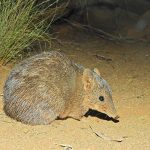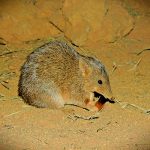GOLDEN BANDICOOT
(Isoodon auratus)
The Golden Bandicoot – A Small Treasure of Australia
Imagine a warm, dusky evening in northern Australia. The air is still, save for the faint rustle of spinifex grass. In this quiet moment, a small figure emerges from the shadows — the Golden bandicoot. About the size of a rabbit, it glimmers with a soft golden-brown coat that blends perfectly into the sandy, sunburnt earth. Its short, rounded ears twitch at the slightest sound, while its pointed nose sweeps the ground, searching for the scent of food.
Appearance and Adaptations
The Golden bandicoot’s dense, silky fur is more than just attractive — it’s a perfect camouflage against predators, helping it disappear into its surroundings.
- Length: 20–30 cm (body)
- Coat: Golden-brown with a pale underbelly
- Features: Short, rounded ears; pointed snout; strong forelimbs
Its compact body and powerful digging claws are superb tools for foraging and creating small burrows, where it can rest during the day, hidden from the heat and danger.
Range and Habitat
Once found across much of northern Australia, the Golden bandicoot’s range has greatly reduced. Today, it survives in scattered populations:
- Offshore islands: Barrow Island, Middle Island
- Mainland strongholds: Parts of the Kimberley region, Western Australia
Its habitats are varied — from spinifex grasslands to shrubs and open woodlands, environments where it can both hide and hunt effectively.
Diet and Ecological Role
The Golden bandicoot is an omnivore with a taste for variety:
- Insects and larvae
- Small reptiles
- Seeds and fruits
By digging for food, it aerates the soil, mixes nutrients, and helps seeds germinate. This makes it a key contributor to ecosystem health — a quiet gardener of the Australian landscape.
Life Cycle and Breeding
Golden bandicoots have one of the shortest gestation periods among mammals — just 12 days.
- After birth, the young crawl into the mother’s pouch to develop further.
- Litters usually contain 2–3 young.
- A female can produce multiple litters in a year, helping the species recover quickly if conditions are right.
Their lifespan in the wild is generally two to three years, though this can be cut short by predators or harsh environmental changes.
Threats and Conservation Status
The IUCN lists the Golden bandicoot as Vulnerable, with main threats including:
- Habitat loss from land clearing and changes in vegetation
- Predation by introduced species like cats and foxes
- Fire regime changes, which can destroy shelter and food sources
Conservation work focuses on:
- Protecting and restoring habitats
- Controlling predators
- Maintaining healthy, predator-free island populations
Behaviour and Communication
Golden bandicoots are nocturnal, emerging under cover of darkness to forage. They are generally silent, but can make soft grunts and squeaks during social interactions or when disturbed — sounds so quiet they can be missed unless you are close and listening carefully.
Cultural Significance
Among the Yolngu people of northern Australia, the Golden bandicoot is known as Wan’kurra, a name that reflects the deep, long-standing relationship between Indigenous communities and the land’s wildlife.
Why They Matter
The Golden bandicoot is more than a charming creature. It’s a reminder of the delicate balance of Australia’s ecosystems. Protecting it means safeguarding the intricate web of life that depends on healthy soil, native plants, and the absence of invasive predators.
If we lose the Golden bandicoot, we lose a piece of Australia’s natural heritage — and a vital player in keeping the land alive.
Quick Facts: Golden Bandicoot (Isoodon auratus)
| Feature | Detail |
|---|---|
| Size | 20–30 cm body length |
| Lifespan | 2–3 years |
| Diet | Insects, reptiles, seeds, fruits |
| Gestation | ~12 days |
| Conservation Status | Vulnerable (IUCN) |
| Key Threats | Habitat loss, introduced predators, fire changes |
| Cultural Name | Wan’kurra (Yolngu) |



